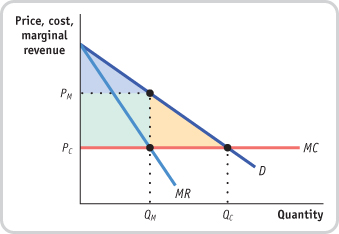Question 8.8
3. Suppose a monopolist mistakenly believes that its marginal revenue is always equal to the market price. Assuming constant marginal cost and no fixed cost, draw a diagram comparing the level of profit, consumer surplus, total surplus, and deadweight loss for this misguided monopolist compared to a smart monopolist.
As shown in the accompanying diagram, a profit-maximizing monopolist produces QM, the output level at which MR = MC. A monopolist who mistakenly believes that P = MR produces the output level at which P = MC (when, in fact, P > MR, and at the true profit-maximizing level of output, P > MR = MC). This misguided monopolist will produce the output level QC, where the demand curve crosses the marginal cost curve—the same output level produced if the industry were perfectly competitive. It will charge the price PC, which is equal to marginal cost, and make zero profit. The entire shaded area is equal to the consumer surplus, which is also equal to total surplus in this case (since the monopolist receives zero producer surplus). There is no deadweight loss since every consumer who is willing to pay as much as or more than marginal cost gets the good. A smart monopolist, however, will produce the output level QM and charge the price PM. Profit equals the green area, consumer surplus corresponds to the blue area, and total surplus is equal to the sum of the green and blue areas. The yellow area is the deadweight loss generated by the monopolist.
